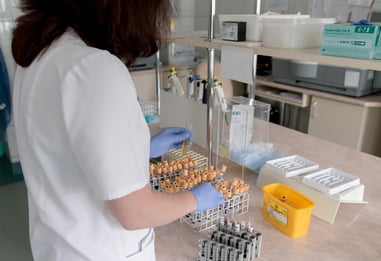 Whether your laboratory is used to conduct biomedical research, test product safety, or pioneer new technologies, you want to keep everyone connected with your lab safe. One often-overlooked aspect of laboratory safety is the floor itself.
Whether your laboratory is used to conduct biomedical research, test product safety, or pioneer new technologies, you want to keep everyone connected with your lab safe. One often-overlooked aspect of laboratory safety is the floor itself.
Not only should your floor help prevent accidents such as trips and falls, it should also be easy to keep sanitary.
While the exact flooring solution for your facility will depend on your field, there are several common factors to consider when choosing flooring for your laboratory:
Ease of Cleaning
You’ll need to sweep and sanitize your laboratory floor regularly, and these tasks are more efficiently completed on a smooth surface, without cracks, joints, or grout that can trap debris or moisture. The floor should also be able to withstand high temperatures and cleaning solutions without warping or breaking down.
While concrete is a simple, strong, and economic choice, it does have a major drawback—it’s technically a porous substance. Though you typically can’t see the network of air pockets throughout the surface, spilled liquids can easily seep into them and cause staining and slick spots. Under the wrong conditions, it can harbor microbes and store chemical contaminants, compromising the lab’s air quality.
A smooth floor coating such as industrial-strength epoxy or a urethane (or a combination of the two) can be installed over the existing concrete flooring and provide this ease of cleaning.
Durability
You’ll also want flooring that’s resistant to cracks, scratches, or abrasions (which, again, can create opportunities for debris to be trapped.) You’ll need to avoid issues such as spalling, which can create a tripping hazard or create logistical challenges when moving items via cart.
In addition, you don’t want to have to shut down operations every year or so to replace the flooring, so longevity is key. Both epoxy and urethane coatings offer high levels of durability, and if properly installed and cared for, can last for several years before needing to be replaced.
Custom Safety Features
Depending on your industry, you may need to have a specialized coating that can further protect your employees and your work. Some of these are enhanced epoxies, while others have a completely different formula.
Some enhanced safety options include:
- Extreme chemical resistance – An epoxy or urethane floor coating has a fair degree of resistance to staining and damage from occasionally chemicals. If your laboratory deals with high volumes of especially corrosive substances, it’s worth investing in a more specialized chemical-resistant floor.
- Electrostatic dissipative flooring - For research involving flammable substances, sensitive computers, or equipment that can be damaged by static charges, an ESD floor coating will prevent static buildup and protect your equipment and workers.
- USDA-approved flooring – If you work with biological, medical, or food-related substances, you can opt for a floor coating designed to inhibit bacterial or fungal growth.
- Anti-slip surfaces - If your laboratory flooring is often wet, or if you have an eye-wash station or emergency shower installed, it’s imperative that your flooring provides enough texture to prevent slip-and-fall accidents.
If you’re located in the Southeastern U.S. and you need a customized flooring solution for your research laboratory, contact an expert at CPC Floor Coatings. We provide free estimates, and we’d love to help you determine the right solution for your lab.

